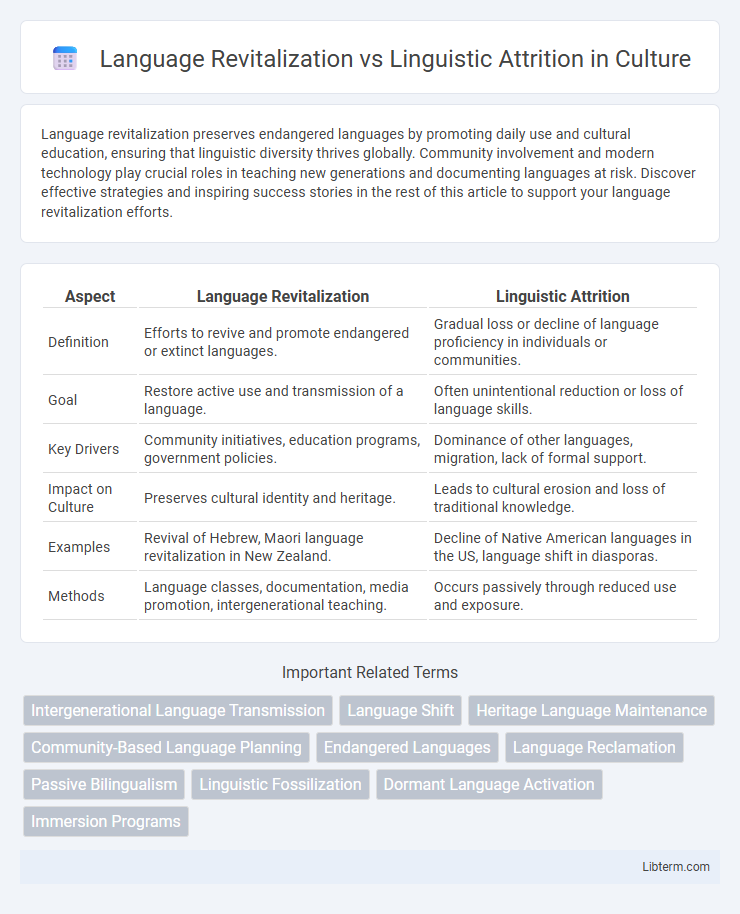Language revitalization preserves endangered languages by promoting daily use and cultural education, ensuring that linguistic diversity thrives globally. Community involvement and modern technology play crucial roles in teaching new generations and documenting languages at risk. Discover effective strategies and inspiring success stories in the rest of this article to support your language revitalization efforts.
Table of Comparison
| Aspect | Language Revitalization | Linguistic Attrition |
|---|---|---|
| Definition | Efforts to revive and promote endangered or extinct languages. | Gradual loss or decline of language proficiency in individuals or communities. |
| Goal | Restore active use and transmission of a language. | Often unintentional reduction or loss of language skills. |
| Key Drivers | Community initiatives, education programs, government policies. | Dominance of other languages, migration, lack of formal support. |
| Impact on Culture | Preserves cultural identity and heritage. | Leads to cultural erosion and loss of traditional knowledge. |
| Examples | Revival of Hebrew, Maori language revitalization in New Zealand. | Decline of Native American languages in the US, language shift in diasporas. |
| Methods | Language classes, documentation, media promotion, intergenerational teaching. | Occurs passively through reduced use and exposure. |
Understanding Language Revitalization
Language revitalization involves systematic efforts to revive endangered or dormant languages by community-driven programs, educational initiatives, and government policies that promote usage and transmission. This process integrates documentation, curriculum development, and media engagement to restore linguistic vitality and cultural identity. Understanding language revitalization highlights the importance of socio-political support and intergenerational language practice to counteract linguistic attrition effectively.
Defining Linguistic Attrition
Linguistic attrition refers to the gradual loss of a language's proficiency or elements by speakers, often due to reduced use or dominance of another language in their environment. It manifests through declining vocabulary, grammar changes, and reduced fluency observed in both first and second language speakers. This phenomenon contrasts with language revitalization, which aims to restore and promote endangered languages to prevent such attrition.
Causes of Language Decline
Language decline primarily stems from social, economic, and political pressures that favor dominant languages over minority ones, leading to a gradual loss of native speakers. Factors such as urbanization, globalization, enforced language policies, and intergenerational language discontinuity contribute significantly to linguistic attrition. These causes undermine the transmission of endangered languages, making revitalization efforts crucial for preserving linguistic diversity.
Consequences of Linguistic Attrition
Linguistic attrition leads to the loss of vocabulary, syntax, and phonetic nuances, severely impacting cultural heritage and community identity. As native speakers diminish, intergenerational transmission weakens, resulting in diminished linguistic diversity and impaired cognitive benefits linked to bilingualism. This decline undermines language revitalization efforts by reducing available resources and fluent speakers critical for effective language education and preservation programs.
Strategies for Language Revitalization
Effective language revitalization strategies include community-based education programs that immerse younger generations in the endangered language through schools and cultural activities. Technology integration, such as mobile apps and social media platforms, supports daily practice and global connectivity among speakers. Government policies that fund language documentation and promote official recognition are crucial for sustaining long-term revival efforts.
Role of Communities in Language Preservation
Communities serve as the cornerstone for language revitalization by actively engaging in the transmission of native languages through culturally relevant education and daily practice. Social cohesion within these groups fosters intergenerational communication, which is critical in reversing linguistic attrition caused by globalization and cultural assimilation. Empowering community members with resources and platforms promotes sustained language use, effectively countering the decline of endangered languages.
Government Policies and Language Support
Government policies play a crucial role in language revitalization by funding educational programs, promoting bilingual signage, and supporting community media, which counteracts linguistic attrition by increasing language use and prestige. Effective language support includes creating comprehensive language documentation, offering teacher training for heritage languages, and implementing legal frameworks that recognize minority languages. Countries with proactive language policies, such as New Zealand's Maori language initiatives and Canada's Indigenous language acts, demonstrate significant improvements in reversing language decline.
Technology’s Impact on Language Survival
Technology plays a critical role in language revitalization by providing digital platforms for documentation, learning, and communication of endangered languages, enhancing accessibility and engagement among younger speakers. Conversely, linguistic attrition accelerates as dominant languages dominate online spaces, leading to decreased use and transmission of minority languages in digital environments. Innovative apps, social media, and AI-driven tools contribute to both preserving endangered languages and highlighting challenges posed by technological globalization on language survival.
Case Studies: Successes and Failures
Language revitalization efforts in cases such as the revival of Hebrew in Israel and Maori in New Zealand demonstrate successful strategies through community engagement and institutional support, boosting linguistic pride and daily usage. Conversely, linguistic attrition is evident in the decline of indigenous languages like Yuchi in the United States and Manx in the Isle of Man, where lack of sustained intervention and sociopolitical pressures led to diminished fluency across generations. Detailed case studies reveal that sustained funding, educational integration, and media presence are key factors distinguishing successful revitalization from ongoing linguistic loss.
The Future of Endangered Languages
Language revitalization efforts are increasingly crucial as nearly 40% of the world's approximately 7,000 languages face extinction by the end of the century. Strategies such as community-driven education programs, digital archiving, and intergenerational language transmission play pivotal roles in reversing linguistic attrition. The future of endangered languages depends on sustained global collaboration and innovative technologies to preserve cultural diversity and linguistic heritage.
Language Revitalization Infographic

 libterm.com
libterm.com